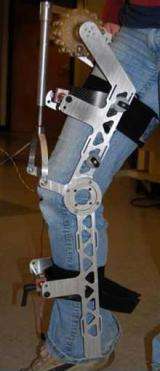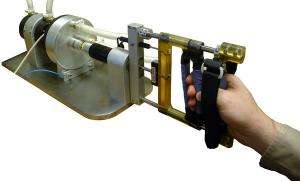November 13, 2009 weblog
Robotic Devices Providing Home-Care Rehabilitation (w/ Video)

(PhysOrg.com) -- A group of researchers, at Northeastern University, have developed several portable robotic devices to aid in the rehabilitation process of stroke victims. These devices are small enough for patients to continue rehabilitation at home, thereby cutting down on the number of visits to the rehab center.
According to the National Stroke Association, stroke is the leading cause of disability in the US. Over two-thirds of stroke survivors are left with some form of disability. This has led researchers to develop robotic devices that can provide forces to a patient's arms, hands, legs, or pelvis. By using such devices, researchers hope that smoother motion would help measure patients' progress more precisely and provide greater comfort during rehab.
Researchers have developed devices for the wrist, knee, ankle, and pelvis that are portable and inexpensive to rent from rehabilitation centers and can be taken home.
By using a substance called electro-rheological fluid the resistance of the robotic device is increased whenever an electric current is applied. By using this fluid the size of the mechanical components can be kept small. Besides the smaller size and the reduce weight, the fluid-based motors give the patient a smoother motion.
Northeastern University has developed an active knee rehabilitation orthotic device, called AKROD that uses rheological fluid as a brake. The AKROD device is made up of two lightweight circular braces above and below the knee. The fluid brake, gears and sensors are positioned alongside the knee.

A rehabilitation device for the hand that's made of a gripper handle connected to gears and sensors has also been tested. This device is driven by two actuators and utilizes the electro-rheological fluid to increase or decrease the resistance in the patient's hand as they navigate through a video game maze. A version has also been created that can be used in an MRI to image the brain as the patient is performing the hand exercises.
All the devices still need to go through clinical trials before they can become available to the public. Home-care rehabilitation, using these robotic devices, can help not just people recovering from a stroke but also other conditions such as cerebral palsy or a degenerative muscle disease.
More Information:
• New York Presbyterian
• Active Knee Rehabilitation Orthotic Devices (AKROD)
Via: Technology Review
© 2009 PhysOrg.com

















